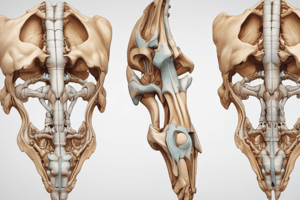Podcast
Questions and Answers
What characterizes fibrous joints?
What characterizes fibrous joints?
- They allow for limited movement. (correct)
- They involve cartilage between the bones.
- They are connected by fibrous tissue.
- They allow for a wide range of movement.
Which type of joint is characterized by a temporary cartilage connection?
Which type of joint is characterized by a temporary cartilage connection?
- Synovial joints
- Secondary cartilaginous joints
- Primary cartilaginous joints (correct)
- Fibrous joints
Which of the following joints allows for gliding movements?
Which of the following joints allows for gliding movements?
- Uniaxial joint
- Plane synovial joint (correct)
- Ellipsoid joint
- Ball and socket joint
What is a key feature of synovial joints?
What is a key feature of synovial joints?
Which movement is associated with polyaxial synovial joints?
Which movement is associated with polyaxial synovial joints?
Cartilaginous joints provide what type of movement?
Cartilaginous joints provide what type of movement?
What type of joint is formed when a ball articulates with a socket?
What type of joint is formed when a ball articulates with a socket?
What distinguishes secondary cartilaginous joints from primary cartilaginous joints?
What distinguishes secondary cartilaginous joints from primary cartilaginous joints?
Flashcards
Fibrous Joints
Fibrous Joints
Joints where bones are connected by fibrous tissue, and there is no movement.
Cartilaginous Joints
Cartilaginous Joints
Joints where bones are connected by cartilage, allowing limited or no movement.
Synovial Joints
Synovial Joints
Joints with a special structure that enable a wide range of movement, containing synovial fluid.
Uniaxial Joint
Uniaxial Joint
Signup and view all the flashcards
Biaxial Joint
Biaxial Joint
Signup and view all the flashcards
Polyaxial Joint
Polyaxial Joint
Signup and view all the flashcards
Plane Joint
Plane Joint
Signup and view all the flashcards
Types of Fibrous Joints
Types of Fibrous Joints
Signup and view all the flashcards
Study Notes
General Anatomy for Public Health - Practical 3: Joints
- A joint is the point where two or more bones meet.
- Joints are categorized by the material (tissue) separating the bones: fibrous, cartilaginous, and synovial.
- Fibrous joints: Bones connected by fibrous tissue; no movement.
- Examples: sutures of the skull, gomphosis (teeth in jaw sockets), syndesmosis (tibio-fibular joint).
- Cartilaginous joints: Bones connected by cartilage; limited movement.
- Subtypes:
- Primary (synchondrosis): Temporary cartilage between bones; no movement (e.g., epiphyseal plates in long bones).
- Secondary (synchondrosis): Permanent cartilage between bones; limited movement (e.g., intervertebral discs, pubic symphysis).
- Subtypes:
- Synovial joints: Have a special structure; range of movement.
- Classified by the number of axes of movement: uniaxial, biaxial, polyaxial, plane.
- Uniaxial: One axis of movement (e.g., hinge, pivot).
- Biaxial: Two axes of movement (e.g., condyloid, saddle).
- Polyaxial: Multiple axes of movement (e.g., ball and socket).
- Plane: Gliding movement (e.g., intercarpal).
- Classified by the number of axes of movement: uniaxial, biaxial, polyaxial, plane.
- Factors affecting joint stability:
- Bony structure, surrounding muscles, ligaments.
Studying That Suits You
Use AI to generate personalized quizzes and flashcards to suit your learning preferences.
Related Documents
Description
Explore the various types of joints in the human body through this practical quiz. Understand the differences between fibrous, cartilaginous, and synovial joints, along with their characteristics and examples. Test your knowledge on how these joints facilitate movement and their structural classifications.




